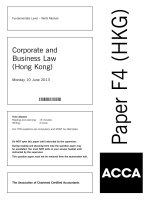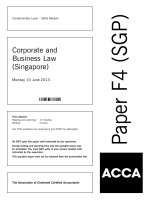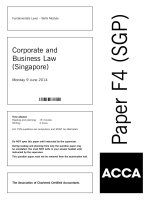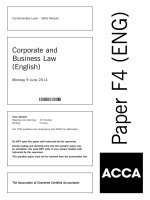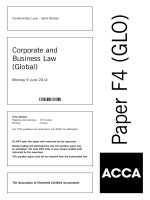ACCA f4 corporate and business law global 2013 dec a
Bạn đang xem bản rút gọn của tài liệu. Xem và tải ngay bản đầy đủ của tài liệu tại đây (173.41 KB, 11 trang )
Answers
Fundamentals Level – Skills Module, Paper F4 (GLO)
Corporate and Business Law (Global)
December 2013 Answers
In relation to aspects of business law, the default law and cases relate to the United Kingdom; however, relevant law and cases from
other jurisdictions will be credited where appropriate.
1
This question requires candidates to explain the role of three elements of the constitution in regard to the creation and operation
of law. At the outset it has to be made clear that the institutions have different roles and powers within different constitutions. In
particular, there is a distinct difference between the United Kingdom and other constitutions. The question by implication requires
some consideration of the doctrine of the separation of powers. The idea of the separation of powers is posited on the existence of
three distinct functions of government, the legislative, executive and judicial functions, and the conviction that these functions
should be kept apart in order to prevent the centralisation of too much power. Establishing the appropriate relationship between
the actions of the state and the legal control over those actions crucially involves a consideration of whether there is any absolute
limit on the authority of the government of the day. In some states, there is a strong model of the separation of powers with the
three elements possessing equal power. However, the situation in the United Kingdom is not of this nature due to the operation of
the doctrine of parliamentary sovereignty as will be considered in detail below.
(a)
The legislature
This is the body within the constitution in which the power of making law is located. Such law takes the form of legislation.
Under democratic constitutions the body will normally be elected. In countries with a written constitution, there are limits to
the power of the legislature to make law, in that it is not permissible for laws to be made which conflict with the rights provided
under the constitution. If any such law is passed, it is open to challenge in the courts, which may strike it down as being
unconstitutional. However, the United Kingdom has no written constitution as such and functions under the doctrine of
parliamentary sovereignty. This effectively means that Parliament is not just the ultimate source of law, but it can make such
law as it determines, which cannot be challenged in the courts as to its content. Even the Human Rights Act 1998, which
introduced the European Convention of Human Rights and Fundamental Freedoms into United Kingdom law, maintains the
doctrine of parliamentary sovereignty, to the extent that the courts cannot declare primary legislation to be invalid on the
grounds that it conflicts with the convention. Courts may issue a declaration of incompatibility, but such a declaration does
not invalidate the legislation in question and any action to remedy the conflict must be undertaken by the legislature.
(b)
The executive
This institution, as its name suggests, is the one which executes the law, i.e. carries it into effect. It is essentially the
government operating through the instrument of the state, such as the civil service and other state functionaries. In theory,
the executive implements rather than creates the law and is subject to the scrutiny of the legislature and the judiciary.
However, with the reality of political control over the legislature it is sometimes claimed that the executive has become too
powerful. Once again this has been particularly claimed in relation to the United Kingdom constitution where some have
suggested that the legislature is under the firm control of the political party which commands the majority of the members of
the House of Commons. The executive government is drawn from the party with the majority of support in the democratically
elected House of Commons. Such control enables the government to ensure that its particular political agenda is pursued
through the enactment of laws.
(c)
The judiciary
The role of the judiciary is to decide issues in relation to the law of the state in which they are located. A corollary of this
description is the conclusion that it is not the function of the judges to make law. As has been stated, in states where there
is a strong separation of powers, the judiciary have the power to control the functioning of both the executive and the
legislature to the extent that they must act within the limits of the constitution. Also, as has also been stated, this is not the
situation in the United Kingdom where the judiciary are subject to the sovereign power of Parliament. However, the United
Kingdom and other common law systems operate under the other apparently anomalous situation whereby that very common
law is recognised to be the creation of the judges through their decision in cases. Equally, it should also be recognised that
judges have power to influence the meaning and operation of legislation through the fact that it is they, the judges, who
interpret it and give it its effective meaning. Such power of making law through interpretation is not peculiar to common law
systems and can be found to a greater or lesser degree in all legal systems.
2
(a)
‘Recourse against an arbitration award’ is simply the technical term for an appeal against the award. Article 34 of the
UNCITRAL Model Law on International Commercial Arbitration allows for a party to an international arbitration to apply to a
court to set aside an arbitration order. It should be noted at the outset that ‘recourse’ means resort to a court, i.e. an organ
of the judicial system of a state. This is distinct from any procedure agreed upon by the parties to allow an appeal to a second
tier arbitral tribunal. The reason for Article 34 is that national laws on arbitration allow a large variety of means of recourse
against arbitration awards with a consequential delay in finalising the dispute. In an endeavour to forestall such delaying
tactics, Article 34 allows only one type of recourse, to the exclusion of any other means of recourse regulated in another
procedural law of the state in question and establishes a list of limited grounds on which any award may be set aside. An
application for setting aside under Article 34 must be made within three months of receipt of the award.
7
(b)
Paragraph 1 of Article 34 establishes categorically that recourse to a court against an arbitral award may only be made in
line with the conditions set out in the subsequent paragraphs of the Article.
Paragraph (2) goes on to provide that an arbitration award may be set aside by the court only if the party making the
application furnishes proof that:
(i)
a party to the arbitration agreement was under some incapacity; or the agreement is not valid under the laws to which
the parties have subjected it. If there is no indication of applicable law, then the law of the state hearing the application
will be the referent;
(ii)
the party making the application was not given proper notice of the appointment of an arbitrator or of the arbitral
proceedings or was otherwise unable to present their case;
(iii) the award dealt with a dispute not contemplated by or not falling within the terms of the submission to arbitration, or
contained decisions on matters beyond the scope of the submission to arbitration. However, if the decisions on the
matters submitted to arbitration can be separated from those not submitted, then only that part of the award relating to
the issues not submitted to arbitration may be set aside;
(iv) the composition of the arbitral tribunal or the arbitral procedure was not in accordance with the agreement of the parties;
(v)
the subject-matter of the dispute is not capable of settlement by arbitration under the law of the state required to enforce
the award;
(vi) the award is in conflict with the public policy of that state.
The court, when asked to set aside an award, may, where appropriate and so requested by a party, suspend the setting aside
proceedings for a period of time determined by it in order to give the arbitral tribunal an opportunity to resume the arbitral
proceedings or to take such other action as in the arbitral tribunal’s opinion will eliminate the grounds for setting aside.
The grounds for setting aside a decision are almost identical to those for refusing recognition or enforcement under Article 36,
but there are significant practical differences between the two procedures. First, the grounds relating to public policy ((vi)
above), including non-arbitrability, may differ depending on the state in question. Second, the grounds for refusal of
recognition or enforcement are valid and effective only in the state where the successful party seeks enforcement, whilst the
setting aside of an award at the place of origin prevents enforcement of that award in all other states under Article 36(1)(a)(v)
of the Model Law.
3
Compared to the obligations of the seller, the general obligations of the buyer under the UN Convention on the International Sale
of Goods are less extensive and relatively simple; they are to pay the price for the goods and take delivery of them as required by
the contract (Article 53).
Amount of payment
As regards payment, the following provisions apply.
The buyer’s obligation to pay the price includes taking such steps and complying with such formalities as may be required under
the contract or any laws and regulations to enable payment to be made (Article 54).
Where a contract has been validly concluded but does not expressly or implicitly fix or make provision for determining the price,
the parties are considered, in the absence of any indication to the contrary, to have impliedly made reference to the price generally
charged at the time of the conclusion of the contract for such goods sold under comparable circumstances in the trade concerned
(Article 55).
If the price is fixed according to the weight of the goods, in case of doubt it is to be determined by the net weight (Article 56).
Place of payment
If the buyer is not bound to pay the price at any other particular place, they must pay it to the seller, at the seller’s place of business.
However, if the payment is to be made when the goods or documents are handed over, payment should be made at the place
where the handing over takes place. If the seller changes their place of business after the contract has been entered into, they will
be liable for any additional expenses which arise as a consequence of that change (Article 57).
Time of payment
If the contract does not require the buyer to pay the price at any other specific time, they must pay it when the seller places either
the goods, or documents controlling their disposition, at the buyer’s disposal as agreed in the contract. The seller may make
payment a condition for handing over the goods or documents. The buyer, however, is not bound to pay the price until they have
had an opportunity to examine the goods, except where the terms of the contract are inconsistent with the buyer being afforded
such an opportunity (Article 58).
Payment should be on the date fixed by the contract without the seller being required to request payment (Article 59).
8
4
This question requires candidates to explain the concept of limited liability and to consider three alternative categories of
companies; the first unlimited in nature, whilst the second and third are limited in different ways.
(a)
In this context, liability refers to the extent to which shareholders in companies are responsible for the debts of their companies
and limited liability indicates that a limit has been placed on such liability. The point is that the limitation on liability is enjoyed
by the member shareholders rather than the company. One of the major advantages of forming a company is that the
members of the company may achieve limited liability. The great majority of registered companies are limited liability
companies. This means that the maximum liability of shareholders is fixed and cannot be increased without their agreement.
There are two ways of establishing limited liability in a relation to a registered company.
Members of ordinary partnerships, formed under the Partnership Act 1890, do not have the advantage of limited liability and
are personally liable for any partnership debts. However, non-active members of partnerships formed under the Limited
Partnerships Act 1907 may benefit from limited liability, as long as they do not get involved in the operation of the business.
All members of partnerships formed under the Limited Liability Partnerships Act 2000 benefit from limited liability set at the
extent of their capital contribution.
(b)
Section 3 Companies Act (CA) 2006 sets out the various types of companies which can be registered in terms of different
liabilities.
(i)
Companies can be formed without limited liability. These, by virtue of s.3(4) CA 2006, are referred to as unlimited
companies. Such companies are incorporated under the Companies Acts and receive all the benefits which flow from
incorporation except limited liability. Consequently, the shareholders in such unlimited companies remain liable to the
full extent of their personal wealth for any unpaid debt of the company. It should be noted that, in line with the doctrine
of separate personality, even in the case of unlimited companies, any subsequent debt is owed to the company and not
directly to the creditors of the company. The compensating benefit enjoyed by such companies is that they do not have
to submit their accounts and make them available for public inspection.
(ii)
The company limited by guarantee (s.3(3) CA 2006) is restricted to private companies of a non-trading kind such as
charities and professional and educational bodies. It limits the members’ liability to an agreed amount which is only
called on if the company cannot pay its debts on being wound up. In reality, the sum guaranteed is usually a nominal
sum, so no real risk is involved on the part of the guarantor.
(iii) The more common procedure is to limit liability by reference to shares (s.3(2) CA 2006). The effect of this is to limit
liability to the amount remaining unpaid on shares held (s.74(2)(d) Insolvency Act 1986). If the shareholder has paid
the full nominal value of the shares to the company, then that is the end of responsibility with regard to company debts.
Consequently, if the company should subsequently go into insolvent liquidation, the shareholders cannot be required to
contribute to its assets in order to pay off its outstanding debts. Both private and public companies can be formed on
this basis.
5
The Company Directors Disqualification Act (CDDA) 1986 was introduced to control individuals who persistently abused the
various privileges which accompany incorporation, most particularly the privilege of limited liability. The Act applies to more than
just directors and the court may make an order preventing any person (without leave of the court) from being:
–
–
–
–
a director of a company;
a liquidator or administrator of a company;
a receiver or manager of a company’s property; or
in any way, whether directly or indirectly, concerned with or taking part in the promotion, formation or management of a
company.
The CDDA 1986 identifies three distinct categories of conduct, which may, and in some circumstances must, lead the court to
disqualify certain persons from being involved in the management of companies.
(a)
General misconduct in connection with companies
This first category involves the following:
(i)
A conviction for an indictable offence in connection with the promotion, formation, management or liquidation of a
company or with the receivership or management of a company’s property (s.2 CDDA 1986). The maximum period for
disqualification under s.2 is 5 years where the order is made by a court of summary jurisdiction, and 15 years in any
other case.
(ii)
Persistent breaches of companies legislation in relation to provisions which require any return, account or other
document to be filed with, or notice of any matter to be given to, the Registrar of Companies (s.3 CDDA 1986).
Section 3 provides that a person is conclusively proved to be persistently in default where it is shown that, in the five
years ending with the date of the application, they have been adjudged guilty of three or more defaults (s.3(2) CDDA
1986). This is without prejudice to proof of persistent default in any other manner. The maximum period of
disqualification under this section is five years.
9
(iii) Fraud in connection with winding up (s.4 CDDA 1986). A court may make a disqualification order if, in the course of
the winding up of a company, it appears that a person:
(1) has been guilty of an offence for which they are liable under s.993 Companies Act 2006, that is, that they have
knowingly been a party to the carrying on of the business of the company either with the intention of defrauding
the company’s creditors or any other person or for any other fraudulent purpose (s.4(1)(a) CDDA 1986); or
(2) has otherwise been guilty, while an officer or liquidator of the company or receiver or manager of the property of
the company, of any fraud in relation to the company or of any breach of their duty as such officer, liquidator,
receiver or manager (s.4(1)(b) CDDA 1986).
The maximum period of disqualification under this category is 15 years.
(b)
Disqualification for unfitness
The second category covers:
(i)
disqualification of directors of companies which have become insolvent, who are found by the court to be unfit to be
directors (s.6 CDDA 1986). Under s.6, the minimum period of disqualification is 2 years, up to a maximum of 15 years;
(ii)
disqualification after investigation of a company under Pt XIV CA 1985 (it should be noted that this part of the previous
Act still sets out the procedures for company investigations) (s.8 CDDA 1986). Once again, the maximum period of
disqualification is 15 years.
Schedule 1 to the CDDA 1986 sets out certain particulars to which the court is to have regard in deciding whether a person’s
conduct as a director makes them unfit to be concerned in the management of a company. In addition, the courts have given
indications as to what sort of behaviour will render a person liable to be considered unfit to act as a company director. Thus,
in Re Lo-Line Electric Motors Ltd (1988), it was stated that:
‘Ordinary commercial misjudgement is in itself not sufficient to justify disqualification. In the normal case, the conduct
complained of must display a lack of commercial probity, although ... in an extreme case of gross negligence or total
incompetence, disqualification could be appropriate.’
(c)
Other cases for disqualification
This third category relates to:
(i)
participation in fraudulent or wrongful trading under s.213 or s.214 Insolvency Act 1986 (s.10 CDDA 1986);
(ii)
undischarged bankrupts acting as directors (s.11 CDDA 1986); and
(iii) failure to pay under a county court administration order (s.12 CDDA 1986).
For the purposes of most of the CDDA 1986, the court has discretion to make a disqualification order. Where, however, a person
has been found to be an unfit director of an insolvent company, the court has a duty to make a disqualification order (s.6 CDDA
1986). Anyone who acts in contravention of a disqualification order is liable:
6
(i)
to imprisonment for up to two years and/or a fine, on conviction on indictment; or
(ii)
to imprisonment for up to six months and/or a fine not exceeding the statutory maximum, on conviction summarily (s.13
CDDA 1986).
(a)
Section 9 Companies Act (CA) 2006 requires a ‘statement of capital and initial shareholdings’ to be submitted to the registrar
in the application to register a company with share capital. Such a statement is essentially a ‘snapshot’ of a company’s share
capital at the point of registration.
Section 10 CA 2006 requires the statement of capital and initial shareholdings to contain the following information:
–
–
–
–
the total number of shares of the company to be taken on formation by the subscribers to the memorandum;
the aggregate nominal value of those shares;
for each class of shares: prescribed particulars of the rights attached to those shares, the total number of shares of that
class and the aggregate nominal value of shares of that class; and
the amount to be paid up and the amount (if any) to be unpaid on each share (whether on account of the nominal value
of the shares or by way of premium).
The statement must contain such information as may be required to identify the subscribers to the memorandum of
association. With regard to such subscribers, it must state:
–
–
the number, nominal value (of each share) and class of shares to be taken by them on formation, and
the amount to be paid up and the amount (if any) to be unpaid on each share.
Where a subscriber takes shares of more than one class of share, the above information is required for each class.
The foregoing applies to companies limited by shares. Section 11 CA 2006 states that private companies limited by guarantee
must provide details as to those parties entering into the guarantee and the extent of their commitment.
10
(b)
The articles of association are the main element of a company’s constitution and, in effect, they are the rules which govern
a company’s internal affairs. Companies are free to make such rules about their internal affairs as they think appropriate,
subject to the proviso that any such rules must not contain anything that is either contrary to:
–
–
the general law, or
the specific provisions of the Companies Act 2006.
Articles of association form a statutory contract between the company and its members and between each of the members
in their capacity as members (s.33 CA 2006).
Section 18 requires all registered companies to have articles of association, and they have to be contained in a single
document and must be divided into consecutively numbered paragraphs (s.18(3)).
Section 19 gives the Secretary of State the power to prescribe ‘default’ model articles for the different types of company. Such
model articles apply to companies where they have not registered any articles of their own, or have not specifically excluded
the operation of the model article in question. The articles of association for private and public companies are different in
content, in recognition of the essential distinction between the ways in which the two business forms operate.
Section 21 CA 2006 provides for the alteration of articles of association on the passing of a special resolution, requiring a
75% vote in favour of the proposition. Any such alteration has to be made ‘bona fide in the interest of the company as a
whole’. This test involves a subjective element, in that those deciding the alteration must actually believe they are acting in
the interest of the company. There is additionally, however, an objective element requiring that any alteration has to be in the
interest of the ‘individual hypothetical member’ (Greenhalgh v Arderne Cinemas Ltd (1951)).
Articles of association cannot be altered where the alteration would be contrary to specific provisions of the companies
legislation or general law.
In addition, s.22 CA 2006 permits companies to ‘entrench’ provisions in their articles. This means specific provisions may
only be amended or removed if certain conditions are met which are more restrictive than a special resolution. For example,
any such entrenched right may require the agreement of all the members before it can be altered or removed. However, such
rights must not be written so that the articles can never be amended.
Further, there are other ways in which some provisions of the company’s constitution can effectively be made unalterable.
Thus the articles may give a member additional voting power, sufficient to block a resolution to alter articles on particular
points (Bushell v Faith (1970)). Alternatively, the articles may provide that when a meeting is held to vote on a proposed
alteration of the articles, the quorum present must include the member concerned, thus indirectly allowing that person the
power to prevent any alteration by simply refusing to attend the meeting.
7
(a)
Article 2 of the UNCITRAL Model Law on International Credit Transfers contains the following definitions:
(i)
‘Originator’ means the issuer of the first payment order in a credit transfer and may include the sender and the sender’s
bank.
(ii)
‘Sender’ means the person who issues a payment order, including the originator and any intermediary bank involved in
the passage of the credit transfer.
(iii) ‘Receiving bank’ means a bank which receives a payment order and may include the beneficiary’s bank or any
intermediary bank involved in the series of transactions facilitating the credit transfer.
(b)
The model law allocates responsibility for unauthorised payment between sender and receiving bank differently depending on
the circumstances of the case.
Most straight forwardly, Article 5 of the model law makes it clear that the sender is bound by a payment order if they, or some
other person who had their authority to bind them, issued it.
However, the issue arises as to liability where the person who issues the payment order is neither the sender, nor has the
sender’s authority to do so. Examples might be, where the payment order has been forged or the procedure for authenticating
the transfer has been used without the knowledge of the sender. In such a situation, responsibility depends on whether
authentication is by way of signature or a process such as encryption or the use of a code or some other process.
Article 5.2 of the model law provides that where a payment order is subject to authentication, other than by means of
comparing signatures, then the sender will be bound by the payment order, if
(i)
(ii)
the authentication is in the circumstances a commercially reasonable method of security against unauthorised payment
orders; and
the receiving bank complied with the authentication.
Although this provision appears to lay the onus on the sender, by indicating when they will be liable, in reality it reverses that
onus, as the receiving bank will only avoid liability where it has used a commercially reasonable authorisation procedure.
It is important to emphasise that the form of authentication must be commercially reasonable in the circumstances. The
determination of what is commercially reasonable will vary from time to time and from place to place depending on the
technology available; the cost of implementing the technology in comparison with the risk and such other factors as may be
applicable at the time. In effect, what this provides is that if the bank accepts a transfer after carrying out reasonable
authorisation procedures, then the sender will be required to honour the payment.
11
The assumption is that, in the case of an electronic payment order, the receiving bank decides the authentication procedures
it is prepared to implement. Consequently, the bank bears all the risk of an unauthorised payment order where it has not
required and operated ‘commercially reasonable’ authentication procedures. Article 5(3) goes on to provide that the protection
offered to the sender cannot be avoided by any agreement to the contrary.
Article 5.4 of the model law considerably narrows the protection afforded to the receiving bank by providing that it does not
apply where the supposed sender can prove that the payment order did not originate from either:
(i)
(ii)
a present or former employee of theirs, or
a person whose relationship with them enabled that person to gain access to the authentication procedure.
However, if the receiving bank can show that the authentication procedure was revealed to the unauthorised sender through
the fault of the sender themselves, then once again the purported sender will be liable to honour the payment.
Article 5(2) does not apply, however, when the authentication procedure is ‘a mere comparison of signature’, in which case
the otherwise applicable law on the consequences of acting on a forged signature must be applied.
8
Article 79 of the UN Convention on Contracts for the International Sale of Goods explains the extent to which an impediment
beyond their control may allow a person to avoid liability for breach of contract. It does so in general terms without making any
reference to such terms as are typically to be found in the various domestic systems such as ‘hardship’, ‘force majeure’ or ‘Act of
God’. Instead of such an approach, Article 79 sets out a factual description of the circumstances which may excuse failure to
perform.
Under Article 79, when a party fails to perform any of their obligations, they are exempt from paying damages where the failure
to perform was:
(a)
(b)
(c)
due to an impediment beyond their control; and
they could not reasonably have been expected to take that impediment into account when the contract was entered into; and
nor could they have avoided or overcome either the impediment or its consequences.
The exemption may also apply if the failure to perform the contract is a result of the action of a third person who was engaged to
perform the whole or a part of the contract. However, this exemption only applies where both the party in breach of the contract,
and the person whom they engaged, meet the above conditions.
Article 79 only applies to damages and the party in breach may be liable for any other available remedy, including reduction of
the price, if the goods were defective in some way.
The exemption provided by Article 79 only applies during the period while the impediment exists and the party who fails to perform
must give notice to the other party of the impediment and its effect on their ability to perform. If the notice is not received by the
other party within a reasonable time after the party who fails to perform knew or ought to have known of the impediment, Article
79 does not apply and they are liable for damages resulting from such non-receipt.
Applying the rules of Article 79 to the situations in the scenario:
9
(a)
it is apparent that Lou cannot avoid his liability under the contract. The inclement weather was certainly beyond his control,
but he should have been aware of the possibility and the consequences of such weather. Equally he could, and indeed should,
have resourced the necessary tomatoes from other regions in France, or indeed from other countries if necessary.
(b)
Os, on the other hand, at the least has an arguable case that the ‘exceptional’ weather was not only beyond his control, but
that he could not possibly have foreseen the seaway being blocked at so early a time. Additionally, given the quantity of
railway track involved in the contract, it would be economically impossible to complete the delivery by any other means than
by ship.
This question requires candidates to explain the implied authority of a company secretary.
Implied authority is the authority which derives from a person’s position. It arises from the relationship which exists between the
principal and the agent and from which it is assumed that the principal has given authority to the other person to act as their agent.
Thus, it is implied from the particular position held by individuals that they have the authority to enter into contractual relations
on behalf of their principal and third parties are entitled to assume that agents holding a particular position have all the powers
which are usually provided to such an agent. Without actual knowledge to the contrary, they may safely assume that the agent has
the usual authority which goes with their position.
In Watteau v Fenwick (1893), the new owners of a hotel continued to employ the previous owner as its manager. They expressly
forbade him to buy certain articles, including cigars. The manager, however, bought cigars from a third party, who later sued the
owners for payment as the manager’s principal. It was held that the purchase of cigars was within the usual authority of a manager
of such an establishment and that for a limitation on such usual authority to be effective, it must be communicated to any third
party.
In relation to companies, there are many layers of implied authority. For example, a person appointed as managing director usually
is entitled to exercise all the powers of the company. Consequently, a managing director can bind the company in any contract
within its capacity, even if their actual authority has been curtailed in some way. Equally, other agents of the company have different
authority, thus shop assistants are able to bind their employers to contracts within the limited area of their authority.
12
This also applies in relation to company secretaries, just as much as managing directors; the only question is the extent of the
secretary’s implied authority. Although the old authorities such as Houghton & Co v Northard Lowe & Wills (1928) treated company
secretaries as having very little authority to bind their companies, later cases have recognised the important role of the modern
company secretary. Thus in Panorama Developments Ltd v Fidelis Furnishing Fabrics Ltd (1971), the Court of Appeal held that a
company secretary was entitled to ‘sign contracts connected with the administrative side of a company’s affairs’.
Applying the ratio in Panorama Developments Ltd, it is likely that the following results would ensue:
(a)
The contract for the maintenance of the photocopiers may be excessively long and expensive, but there is no doubt that such
a contract is within the ambit of a company secretary’s implied authority and consequently the company, Do Co, will be
required to honour the contract.
(b)
This contract is clearly in breach of Chu’s authority, but the actual contract is within a company secretary’s implied powers
and, as long as Ex Co are unaware of his breach of duty, Do Co will be liable on this contract as well.
(c)
In this case, Chu has not only clearly exceeded his actual authority, but has equally gone beyond his implied authority. In this
situation Do Co will not be liable for the contract.
10 Companies ordinarily raise the money they need to finance their operations through the issue of share capital, but it is equally
common for companies to raise additional capital through borrowing. Such borrowing on the part of the company does not give
the lender any interest in the company but represents a claim against the company. There are two types of security for company
loans:
Fixed charge
In this situation a specific asset of the company is made subject to a charge in order to secure a debt. Once the asset is subject
to the fixed charge, the company cannot dispose of it without the consent of the debenture holders. The asset most commonly
subject to fixed charges is land, although any other long-term capital asset may also be charged, as may such intangible assets as
book debts. It would not be appropriate, however, to give a fixed charge against stock-in-trade as the company would be prevented
from freely dealing with it without the prior approval of the debenture holders. Such a situation would obviously prevent the
company from carrying on its day-to-day business. If the company fails to honour the commitments set out in the document
creating the debenture, such as meeting its interest payments, the debenture holders can appoint a receiver who will, if necessary,
sell the asset charged to recover the money owed. If the value of the asset which is subject to the charge is greater than the debt
against which it is charged, then the excess goes to pay off the rest of the company’s debts. If it less than the value of the debt
secured, then the debenture holders will become unsecured creditors for the amount remaining outstanding.
Floating charge
The floating charge is most commonly made in relation to the ‘undertaking and assets’ of a company and does not attach to any
specific property whilst the company meets its requirements as stated in the loan document. The security is provided by all the
property owned by the company, some of which may be continuously changing, such as stock-in-trade. Thus, in contrast to the
fixed charge, the use of the floating charge permits the company to deal with its property without the need to seek the approval of
the debenture holders. However, if the company commits some act of default, such as not meeting its interest payments, or going
into liquidation, the floating charge is said to crystallise. This means that the floating charge becomes a fixed equitable charge over
the assets detailed, and their value may be realised in order to pay the debt owed to the floating charge holder.
All charges, including both fixed and floating, have to be registered with the Companies Registry within 21 days of their creation.
Failure to register the charge as required has the effect of making the charge void, i.e. ineffective, against any other creditor, or the
liquidator of the company. The charge, however, remains valid against the company, which means in effect that the holder of the
charge loses their priority as against other company creditors.
In relation to properly registered charges of the same type, they take priority according to their date of creation. However, as regards
charges of different types, a fixed charge takes priority over a floating charge even though it was created after it. Generally, there
is nothing to prevent the creation of a fixed charge after the issuing of a floating charge, and, as a legal charge against specific
property, that fixed charge will still take priority over the earlier floating charge.
As all the charges in the scenario were properly registered, it follows that all of the fixed charges take precedence over the floating
charges and within each category the charges take priority depending on date of creation, rather than the date of registration.
Consequently the charges assume the following priority:
(i)
Ko-Bank’s loan, secured by a fixed charge created on 5 April;
(ii)
Ina’s loan, secured by a floating charge created on 1 April;
(iii) Jo’s loan, secured by a floating charge created on 3 April.
13
Fundamentals Level – Skills Module, Paper F4 (GLO)
Corporate and Business Law (Global)
1
2
This question requires candidates to explain the three constitutional institutions.
8–10 marks
Clear explanation of each of the elements of the question.
5–7 marks
Fair knowledge of the meaning of each of the three elements, but perhaps lacking in detail.
3–4 marks
Unbalanced answer, not dealing with all elements of the question.
1–2 marks
Limited or confused understanding of the nature of the question.
0 marks
No understanding of the concept under consideration.
This question requires candidates to consider Article 34 of the UNCITRAL Model Law on International Commercial Arbitration
relating to the circumstances under which a party may have recourse against an arbitration award.
(a)
(b)
3
4
December 2013 Marking Scheme
3 marks
Full explanation of the meaning and effect of ‘recourse’.
1–2 marks
Some to fair explanation of the term.
0 marks
No knowledge whatsoever of the concept.
6–7 marks
Good to complete answer which shows a thorough knowledge of the content of Article 34 of the Model Law.
4–5 marks
Fair explanation of the content of Article 34, but perhaps lacking in detail.
1–3 marks
Some basic knowledge of the Model Law but no real depth of understanding.
0 marks
No knowledge whatsoever of the topic.
This question requires candidates to explain the obligations relating to price placed on the buyer under the UN Convention on
Contracts for the International Sale of Goods.
8–10 marks
Thorough answers which show a detailed knowledge of the operation of the Convention.
5–7 marks
Good explanation of the operation of the convention, but perhaps unbalanced and lacking in detail.
3–4 marks
Some basic knowledge of the provisions of the convention, but no real depth of understanding. Perhaps a very
unbalanced answer which only deals with one part of the question.
1–2 marks
Very limited knowledge of the convention provisions on this topic.
0 marks
No knowledge whatsoever on the topic.
(a)
(b)
This question requires candidates to provide an explanation of the concept of limited liability.
3–4 marks
A good to full explanation of limited liability referring to both companies and partnerships.
1–2 marks
Some but incomplete explanation, perhaps lacking in detail.
0 marks
No knowledge of the concept.
(i)
(ii)
2 marks
A full explanation of unlimited liability and why it might be used.
1 mark
Some knowledge but lacking explanation.
0 marks
No knowledge of the topic.
2 marks
For an explanation of limited liability on the basis of guarantee and when it might be used.
1 mark
Some knowledge but lacking explanation.
0 marks
No knowledge of the topic.
(iii) 2 marks
For a thorough explanation of liability limited by reference to the amount unpaid on shares and how it
operates.
1 mark
Some knowledge but lacking explanation.
0 marks
No knowledge of the topic.
15
5
6
This question requires candidates to explain the operation of the UK Company Directors Disqualification Act 1986.
8–10 marks
Thorough to complete answers, showing a detailed understanding of the legislation.
5–7 marks
A clear understanding of the topic, but perhaps lacking in detail. Alternatively, an unbalanced answer showing good
understanding of one part but less in the others.
2–4 marks
Some knowledge, although perhaps not clearly expressed, or very limited in its knowledge and understanding of the
topic.
0–1 mark
Little or no knowledge of the topic.
This question requires an explanation of two compulsory documents required for the formation of a limited company.
(a)
(b)
7
A good to full explanation of the statement of capital and initial shareholdings.
1–2 marks
Some but incomplete explanation, perhaps lacking in detail.
0 marks
No knowledge of the concept.
5–6 marks
A good to full explanation of articles of association and how they can be changed.
3–4 marks
Some but incomplete explanation, perhaps lacking in detail or not dealing with the procedure for altering
articles.
1–2 marks
Some but very limited knowledge of articles of association.
0 marks
No knowledge of the concept.
This question requires a knowledge of the UNCITRAL model law on the international credit transfers.
(a)
(b)
8
3–4 marks
This part of the question requires some preliminary explanation of three core terms in the model law.
3 marks
A clear explanation of all three terms.
1–2 marks
Some but limited knowledge, lacking any detail.
0 marks
No knowledge of any of the terms.
This part of the question requires candidates to explain how the model law addresses the issue of unauthorised payment
orders.
6–7 marks
A thorough answer, which explains fully the way in which the model law looks to deal with unauthorised
transfers. The very best answers may provide examples to highlight their explanation.
4–5 marks
A less complete answer, perhaps lacking in detail or unbalanced in that it does not deal with some aspects of
the question.
2–3 marks
Some but limited knowledge of the topic.
0–1 mark
Little, if any, awareness of the topic.
This question requires an explanation of Article 79 of the UN Convention on Contracts for the International Sale of Goods.
8–10 marks
Accurate analysis of the situation together with a detailed knowledge of the legal principles involved linked to a
sound application of those principles.
5–7 marks
Sound knowledge of the law but perhaps lacking in application or alternatively not showing a sufficiently clear
understanding of the legal principles involved.
3–4 marks
Weak or unbalanced answer. Perhaps aware of the nature of the problem but lacking in clear knowledge of the
principles or deficient in relation to how those principles should be applied.
1–2 marks
Very weak answer. Perhaps mentioning some of the issues involved in the question but failing to consider them in
any detail.
0 marks
No knowledge whatsoever of the topic under consideration.
16
9
This question requires candidates to explain the implied authority of a company secretary and apply the law relating to that topic
appropriately to the three distinct contracts.
8–10 marks
Thorough to complete answers, showing a detailed understanding of the implied authority as it applies to company
secretaries and applying that law accurately.
5–7 marks
A clear understanding of the topic, but perhaps lacking in detail. Alternatively, an unbalanced answer showing good
understanding of one part but less in the others. Perhaps not applying the law accurately in the various contracts.
2–4 marks
Some knowledge, although perhaps not clearly expressed, or very limited in its knowledge and understanding of the
topic. Or perhaps the knowledge is not accurately applied.
0–1 mark
Little or no knowledge of the underlying topic.
10 This question relates to specific aspects of the law relating to loans extended to companies. It requires an explanation of the
different types of security and an understanding of the procedure for registering charges securing loans and the priority of any such
charges.
8–10 marks
Thorough to complete answers, showing a detailed understanding of the law relating to debentures and charges
securing them. The various loans will be placed in the correct order with an explanation of why that order applies.
5–7 marks
A clear understanding of the topic, but perhaps lacking in detail. Alternatively, an unbalanced answer showing good
understanding of one part but less in the others. Perhaps not applying the law accurately in the examples provided.
2–4 marks
Some knowledge, although perhaps not clearly expressed, or very limited in its knowledge and understanding of the
topic. Or perhaps the knowledge is not accurately applied.
0–1 mark
Little or no knowledge of the underlying topic.
17

